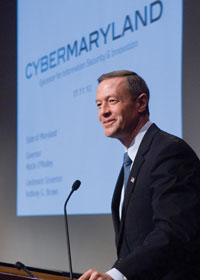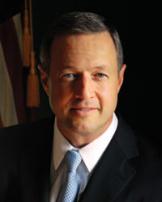Addressing what is quickly becoming a threat of global proportions to the security of computer networks worldwide, Maryland has launched an aggressive plan that positions the State as the nation’s epicenter for cyber security and seeks to build on the already enviable information technology assets that call Maryland home.
After months of in-depth research and guidance from more than 50 public and private sector information technology and cyber security experts, Maryland Governor Martin O’Malley unveiled in January CyberMaryland, a plan which highlights the State’s key role in supporting President Barack Obama’s national cyber security initiative and is the first comprehensive inventory of any State’s cyber security assets.
“Cyber security touches everything we do – from grocery shopping to banking, to heating our homes and talking on cell phones. With 50,000 new computer viruses emerging every day and hackers becoming increasingly advanced, the need to protect our country, our companies and our families has never been more urgent,” said Governor O’Malley, who serves as co-Lead on Homeland Security for the National Governors’ Association Public Safety Task Force and sits on the U.S. Homeland Security Advisory Council.
O’Malley continued, “Maryland is poised to lead the nation’s war on cyber crime. From the innovative work being conducted at our federal facilities, our universities and Maryland companies both large and small, to our highly-educated IT workforce, we have a duty to ensure the safety and security of every American citizen against this growing threat.”
Increasing Cyber Threats Point to Need for Increased Cyber Security Cyber threats have surged in the last year, with significant jumps in the number of consumers reporting financial fraud, malware infection and password detection, according to the 2009 CSI Computer Crime and Security Survey, which surveyed more than 400 organizations in July 2009. On average, identity theft cost each organization surveyed more than $700,000, while losses from financial fraud cost $450,000.
Cyber threats have surged in the last year, with significant jumps in the number of consumers reporting financial fraud, malware infection and password detection, according to the 2009 CSI Computer Crime and Security Survey, which surveyed more than 400 organizations in July 2009. On average, identity theft cost each organization surveyed more than $700,000, while losses from financial fraud cost $450,000.
Maryland is well equipped to tackle this growing security crisis with the nation’s most concentrated IT assets. Maryland is home to 50 key federal facilities and 12 major military installations, including the National Security Agency, the Army’s Communication and Electronics Command (CECOM), which will soon be locating at Aberdeen Proving Ground, and the Defense Information Systems Agency, which is slated to move to Maryland from Virginia in 2011, bringing 4,300 advanced technology jobs. Combined, these facilities and installations employ nearly 200,000 well-educated, highly-skilled government employees and contractors in cutting-edge research and development and scientific, medical and technological innovations, not counting the estimated 60,000 jobs coming to Maryland as a result of the Base Realignment and Closure process.
“The National Institute of Standards and Technology (NIST) has a longstanding comprehensive program in cyber security research and standards,” said NIST Director Patrick Gallagher. “Our efforts are greatly strengthened through collaborations with the state and private sector, and I welcome Governor O'Malley's strong leadership in this area.”
Maryland is also home to many of the nation’s top defense contractors and has a growing cluster of private sector companies specializing in cyber security. In total, Maryland has one of the highest concentrations of technology jobs in the nation, with 10 percent of jobs classified as technology-related and led the nation in 2009 with the largest growth in computer systems design jobs. Of the more than 11,000 jobs created nationwide in this industry, more than 8,000 were created in Maryland.
“Cyber security is a growing and robust global industry, as more financial service companies, universities and retailers address their security needs and government agencies work to safeguard our nation’s most vital networks,” said Maryland Department of Business and Economic Development Secretary Christian S. Johansson. “With our unparalleled IT assets and a highly-skilled workforce of more than 126,000, Maryland is best prepared to lead the cyber security charge and tap into what is expected to be a more than $800 billion global IT industry in 2010.”
Leader in Education and R&D
Maryland is also a leader in research and development, ranking first in federal R & D obligations per capita, and second in federal R & D investment at $12.2 billion. Maryland is home to several of the nation’s top research universities, including Johns Hopkins and University of Maryland, College Park, the University of Maryland, Baltimore and the University of Maryland, Baltimore County, which combined conduct nearly $1 billion in funded research annually.
To support the cyber industry, Maryland also has the nation’s top rated public school system and is developing an education pipeline to produce highly-skilled workers trained in Science, Technology, Engineering and Math (STEM); has more than 20 colleges and universities that offer computer science degrees, including six State universities that are certified by the NSA as Centers of Academic Excellence; and is home to the nation’s first business accelerator – the Chesapeake Innovation Center – for government innovation, homeland, national and cyber security initiatives.
Cyber Maryland Charts the Future Over the next year, Maryland will work to move forward on the CyberMaryland report’s recommendations though the State’s newly formed Federal Facilities Advisory Board. The 16-member Board will develop a comprehensive assessment of how Maryland can best support and leverage the vast potential of its more than 50 federal facilities and help connect Maryland companies with federal opportunities to create jobs.
Over the next year, Maryland will work to move forward on the CyberMaryland report’s recommendations though the State’s newly formed Federal Facilities Advisory Board. The 16-member Board will develop a comprehensive assessment of how Maryland can best support and leverage the vast potential of its more than 50 federal facilities and help connect Maryland companies with federal opportunities to create jobs.
Key among CyberMaryland’s recommendations is the creation of a National Center of Excellence for Cyber Security in Maryland, which calls for a partnership between Federal and State government, the private sector and academic institutions and includes an incubator; cyber security testing laboratories; information sharing about vulnerabilities in hardware, software and IT systems; education and training; and Cyber Security/IT Law Council to advise the Governor and State leadership.
The recommendations also include launching an aggressive effort to brand Maryland as a hub of cyber intelligence, which would help the State to attract both national and global information technology companies; continuing to focus Maryland’s academic efforts on science, technology, engineering and math (STEM) to meet the ever increasing workforce needs of the cyber and IT industry; and aligning the State’s cyber security best practices with those of the federal government to ensure a cohesive and consistent vision.
“The economic well being and safety of our nation in the global environment requires comprehensive cyber security approaches that address policy, operations, technology, leadership, workforce and budget,” said Rosemary Budd, Booz Allen Hamilton principal and president of the Fort Meade Alliance. “Governor O’Malley’s push to establish a National Center of Excellence for Cyber Security in Maryland, and the implementation of recommendations in the CyberMaryland report, call for collaboration between federal, state, research, academia and private industry. Through our work together, we can provide critical advancements in cyber security solutions.”

